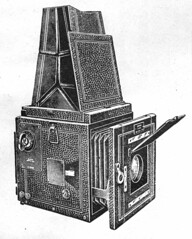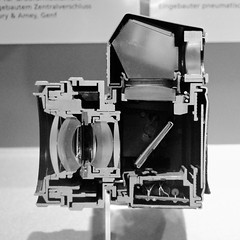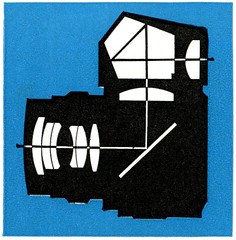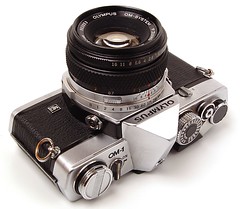SLR
To see a list of SLR cameras, see the Category: SLR.
| ||
| ||
| ||
|
SLR is an acronym for Single Lens Reflex. What does that stand for?
- Single Lens — The camera uses one lens for both taking and viewing. In other words you look through the same lens as the camera uses to expose the film or sensor (as opposed to twin-lens reflex cameras).
- Reflex — The term has the meaning of 'reflected'. Light passing through the lens is reflected upwards by the mirror, and focused onto a ground glass for previewing, as in a TLR [1].
When looking into the viewfinder of an SLR camera, you are looking through the taking lens, via a mirror that sits diagonally behind it blocking the light path to the film plane. Its reflected image explains the term reflex finder.
Contents
Function
When the shutter release of an SLR is tripped, the mirror you had been using to look through the lens swings out of the way. (In a few early SLRs, it is finger pressure on the release plunger which moves the mirror.) This is the reason that the viewfinder always goes black in an SLR when you take a photograph. With the mirror out of the way, the film is now directly in line with the lens, but still shielded by a shutter mechanism. The shutter is now tripped, resulting in the film frame being exposed by the lens.
In most modern SLRs, the aperture of the lens is held wide open when you are focusing and composing. This allows the brightest possible viewfinder image. In older cameras with 'manual stop down lenses' you would begin with the lens aperture to its widest setting while focusing and composing, and then manually change the aperture to your intended exposure setting before releasing the shutter. In modern SLRs, the aperture setting is stopped down automatically, in the instant before exposure.
Once the exposure is complete and the shutter is closed, the mirror (in most modern SLRs), swings back into the taking position and you can once again see through the viewfinder. This is known as an 'instant-return mirror'. In older designs (especially those for medium format film). the mirror will stay in its 'up' position. The view finder will remain black until the photographer resets the mechanism by advancing the film.
In many vintage SLRs (and few modern ones with interchangeable finders), the image on the ground glass is directly seen from above (waist-level finder) — it's upright, but reversed (left to right). In most modern SLRs, the ground-glass image is seen through a prism or arrangement of mirrors atop of the ground glass screen. The view through the prism gives you an upright, unreversed viewfinder image (eye-level finder). The odd shape of this pentaprism gives the tops of 35mm SLRs their characteristic "hump" although different brands may use creative styling to conceal this.
An SLR combined with a digital sensor gives a digital SLR or DSLR.
Pros
- What you see is what you get, or almost. Looking through the same lens as will be used to expose the film means that you do not experience parallax errors like you might in a rangefinder or TLR camera. The only thing to be aware of is that, hidden somewhere in the fine print of your SLRs specifications, will be a viewfinder percentage value. This tells you what percentage of the taking image you will see in the viewfinder. In most SLRs this value is less than 100% indicating that slightly more of the scene than you see through the viewfinder will be exposed on the film. There are rare exceptions, like the original Nikon F and the current Olympus E-3, that do show 100% of the taking image -- but these are exceptions, rather than the rule.
- You always see the image of the taking lens and do not need any additional viewfinders for different focal lengths. This makes the use of unusual focal lengths straightforward. Wide-angle lenses and moderate telephoto lenses are available for rangefinder cameras, but may require accessory viewfinders; and focusing longer telephoto lenses correctly can be challenging.
- Because you look directly through the lens, more accurate focusing is possible. This is especially valuable in close-up and macro work.
- On many SLRs, you can preview the depth of field prior to taking the shot, by stopping down the lens to its taking aperture. The viewfinder image becomes darker but you can see exactly what parts of the picture will be in focus and what will not.
- You can see the effect of any filters or auxiliary lenses fitted, and a TTL exposure meter will automatically take any loss of light through these additions into account.
Cons
- The extra mechanisms for the mirror and prism add bulk and weight to a camera design. Camera designers are skilled at hiding this extra bulk but compare a Nikon F with a Leica of similar vintage to see the difference in size and weight.
- The mirror mechanism adds extra noise when you trip the shutter. Again, compare a Nikon F with a Leica of similar vintage to hear the difference. This extra noise can be a problem if you are in a quiet location or you are trying to be discreet.
- The mirror mechanism can add extra camera shake. The rapid movement of the mirror swinging out of the way can cause vibrations (an effect known as mirror slap) that add to camera shake when you are taking a picture. Camera designers try to remove this effect by cushioning the mirror's movement. With normal shutter speeds this effect is rarely a problem, but with longer exposures it can cause an image to slightly less sharp than it might otherwise be. Some fully featured SLRs add a mirror lockup function to compensate for this effect. This function allows the photographer to manually select when to move the mirror out of the way in advance of taking the exposure. This facility is prized by astro-, night- and some micro-photographers.
- The mirror motion before the shutter can open adds a slight shutter latency to SLR cameras i.e. when you trip the shutter in an SLR it takes a split second longer to expose the film with an SLR than it does with a rangefinder camera or TLR.
- Since the mirror flips out of the way to allow the film to be exposed, the viewfinder blacks out for the period of the exposure (in fact from a little while before to a little while after). Although modern mirror mechanisms are very quick it does mean that you can never see the subject at the actual moment of exposure. Photographers trying to capture fleeting facial expressions may find this frustrating.
Notes
- ↑ The term 'Reflex' has nothing to do with the movement of the mirror, as found in a typical SLR, despite the coincidental alternative meaning 'an involuntary and nearly instantaneous movement in response to a stimulus'. In a twin-lens reflex, the mirror remains stationary; and some SLRs, such as the Canon Pellix have a semi-transparent pellicle mirror, which likewise is fixed in position and does not move.



